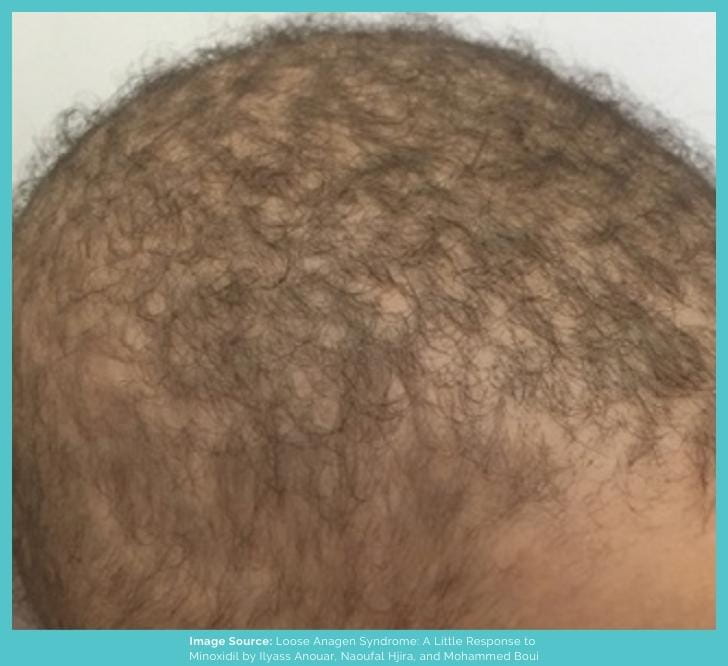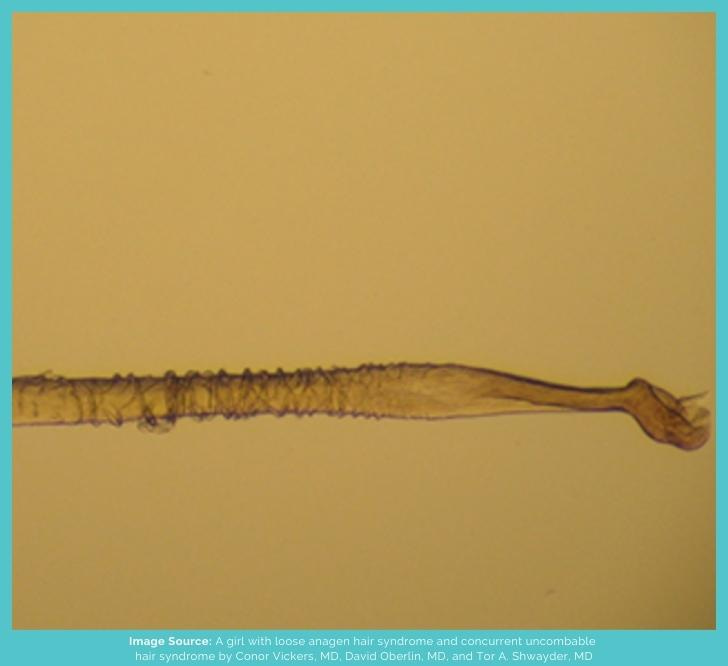Loose anagen syndrome, as the name implies, refers to the hair being loosely anchored into the hair follicles. As a result, it can easily be pulled out of the scalp. So much so that you won’t even feel pain.
“Anagen” is a phase of the hair growth cycle in which the hair actively grows. Normally, 85-90% of the hair is in this phase at any given time, and it lasts for 2-8 years. During this, your hair will continue to develop and push out of the skin.
Unfortunately, in loose anagen syndrome, it’s believed that the anagen phase is stopped prematurely. And that’s why those who have this condition aren’t able to grow their hair long.
In this guide, you’ll learn more about the loose anagen syndrome, if or when it can resolve, and what can be done to treat it.
What Is Loose Anagen Syndrome?
Loose anagen syndrome is a congenital condition that usually causes diffuse hair loss.
Quite often, it’s reported to occur in young Caucasian girls between the ages of 2 and 5, having blonde hair. However, it can also affect boys, adults, and people of other ethnicities.

It’s actually not a very common type of alopecia. According to a study published in the Archives of Dermatology, only 2 to 2.5 cases occur per million people in a year.
There’s nothing wrong with the hair when the child is born. However, as they grow older, it can become:
- Dry
- Short (many don’t even need haircuts)
- Fine
- Lustreless
- Matted
- Sparse
- Limp
- Having different lengths
Also, some people have “bed hair” because the hair at the back of the head (occipital region) rubs against the sheets while sleeping.
It’s considered a reason why this type of hair loss is the worst in that area; the friction further plucks the hair out. The hair can also feel sticky and matted because of this.
And because it’s difficult to tame this type of hair with combing, it can look quite messy.
Still, the scalp isn’t the only area that can be affected by loose anagen hair syndrome. It can also affect eyebrow hair and body hair.
Types Of Loose Anagen Syndrome
Researchers have identified three main types of loose anagen syndrome, which are as follows:
- Type A – Hair is short and sparse (low density)
- Type B – Hair is unruly, and the hair loss is diffuse
- Type C – Excessive hair loss is taking place
Keep in mind that hair loss doesn’t always have to be sparse or diffuse. It can also occur in a patch.
In one of the Case Reports in Dermatology, a Thai boy was diagnosed with loose anagen syndrome with just a single patch of short hair that would shed excessively.
Another important thing to note here is that loose anagen syndrome doesn’t always occur on its own.
It can also be associated with other conditions, such as Noonan syndrome, colobomas, uncombable hair syndrome, eczema, etc.
What Causes Loose Anagen Syndrome?
Loose anagen syndrome is considered an “autosomal-dominant” condition, meaning it has a genetic basis.
Autosomal dominant means that a faulty gene was passed down to the child from one of the parents, and that alone was enough to cause this. But the exact way in which this condition develops is not known.
Some, however, suggest that it happens due to issues in a process called “keratinization.”
It’s when in the process of hair growth, cells get pushed farther and farther away from the skin, die and harden to form keratin (the major protein in hair).
According to Medscape, genetic mutations end up causing abnormalities in the keratinization of the inner root sheath – which protects the growing hair and plays a role in anchoring it.
For one, that can make the hair come out easily. But secondly, it may also halt the anagen phase of the hair growth cycle, so the hair remains short.
Does Loose Anagen Syndrome Go Away?
Fortunately, loose anagen syndrome is something that children grow out of on their own. It’s a self-limiting condition, so the hair should eventually start to grow.

However, according to Medscape, while the hair can become longer, darker and denser with time, the problem of hair being pulled out easily will continue to persist.
But the good news is that since loose anagen syndrome is non-scarring, your hair follicles aren’t destroyed. Therefore, it’s not irreversible.
How Long Does Loose Anagen Syndrome Last?
The American Osteopathic College of Dermatology (AOCD) reports there have been cases of loose anagen syndrome that lasted for 14 years.
However, there are patients who’ve also reported improvement while on certain therapies after a few months and even years.
How To Treat Loose Anagen Syndrome?
While there’s no treatment for loose anagen syndrome, there are case reports of minoxidil helping improve hair growth in these patients.
One case report in Pediatric Dermatology looked into the use of minoxidil 5% solution on a 2-year-old girl and found that it significantly helped. It was given for a period of 2 years and 4 months (although it was tapered).
It’s not exactly known how minoxidil works. Some say it improves blood flow to the scalp, and some researchers also report that this drug may increase the duration of the anagen phase (so hair is able to grow longer).
But other than waiting for the hair to grow back, it’s important to be gentle with your hair. You should avoid tying it too tightly as it’ll pull at the roots.
Similarly, don’t be too rough when you’re combing your hair. Even when you’re washing, be very gentle.
How Do You Diagnose Loose Anagen Syndrome?
Your doctor may do a hair pull test and a microscopic examination (trichogram) of your hair to get a diagnosis of loose anagen syndrome.
According to one research published in the Archives of Dermatology, the number and percentage of loose anagen hair are helpful in determining the presence of this condition during a pull test.
In normal children, 1 or 2 loose anagen hairs come out, but those who have this syndrome end up losing more than 3 (even 10) in the pull test.
And as far as the examination goes, the bulbs of such hair are misshapen. Moreover, the cuticle of the hair looks ruffled.

Conclusion
Loose anagen syndrome is a benign and self-limiting condition in which the hair is very easily pulled out of the follicles on the scalp.
While the condition can resolve on its own (so a hair transplant isn’t necessary), it can still cause a lot of distress because it can last for a long time.
Unfortunately, there’s no fixed treatment for this condition. But some researchers have seen promising results with the use of minoxidil.
However, if you are experiencing abnormal hair loss, it’s important to get in touch with a board-certified medical professional for a diagnosis and treatment plan.
Reviewed and Approved by Trichologist Yaprak Yazan
FAQ
What’s the best shampoo for loose anagen syndrome?
There is no “best shampoo” for loose anagen syndrome because it’s an inherited condition. So, no shampoo can change the underlying genetics of your hair. To not exacerbate your hair loss, however, it might be better to use a mild shampoo.
Short anagen syndrome vs loose anagen syndrome: what’s the difference?
In short anagen syndrome, the duration of the growing anagen phase is reduced, but in loose anagen syndrome problems in hair keratinization prematurely halt the anagen phase.
Is loose anagen syndrome rare?
Loose anagen syndrome is rare as only 1-2 people/million are affected in a year. However, authors of the book “Disorders of Hair and Nails” report 10% of the children experiencing hair loss have loose anagen syndrome.


